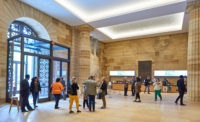Frank Gehry Breaks Ground on Renovation of Philadelphia Museum of Art

A rendering of the renovated Great Stair Hall.
Image courtesy Gehry Partners and KX_L; Philadelphia Museum of Art

The Forum, looking west.
Image courtesy Gehry Partners and KX_L; Philadelphia Museum of Art

The Forum, looking east.
Image courtesy Gehry Partners and KX_L; Philadelphia Museum of Art

A new Gehry-designed stair will wind down from Lenfest Hall.
Image courtesy Gehry Partners and KX_L; Philadelphia Museum of Art

View overlooking the Forum,
Image courtesy Gehry Partners and KX_L; Philadelphia Museum of Art

A rendering of the renovated south lobby.
Image courtesy Gehry Partners and KX_L; Philadelphia Museum of Art

The Gehry renovation will include the renewal of the Vaulted Walkway.
Image courtesy Gehry Partners and KX_L; Philadelphia Museum of Art

Lenfest Hall
Image courtesy Gehry Partners and KX_L; Philadelphia Museum of Art

Formerly a loading dock, this museum’s North Entrance will become a new public access point.
Image courtesy Gehry Partners and KX_L; Philadelphia Museum of Art

Frank Gehry museum director Timothy Rub.
Photo © Architectural Record

The groundbreaking ceremony.
Photo © Philadelphia Museum of Art

Timothy Rub, Frank Gehry, and Gail Harrity, the museum’s president.
Photo © Philadelphia Museum of Art

Frank Gehry.
Photo © Philadelphia Museum of Art

The Vaulted Walkway.
Photo © Architectural Record

Attendees enter the museum’s north entrance for the groundbreaking ceremony. The entrance will be a new public access point after the Gehry renovation.
Photo © Philadelphia Museum of Art















When architects hear the name Frank Gehry, their first thoughts are likely to be of adventurous sculptural forms—forms like those found in his twisty residential skyscraper in New York City or the billowing glass sails that wrap the Fondation Louis Vuitton in Paris. Or, they might envision the colliding titanium-clad volumes that make up the Guggenheim Museum Bilbao in the Basque region of Spain, still famous for transforming the economy of that port city two decades after completion.
However, Gehry Partners’ current project at the Philadelphia Museum of Art, which officially got underway Thursday with a ceremonial groundbreaking, is of a different nature. The work is contained almost entirely within the footprint of the museum’s 1928 Greek Revival building (most will recognize it from the 1976 movie Rocky) at the head of the Benjamin Franklin Parkway.
The primary goal of the $196-million “core project,” as the current phase is known, is to make the museum more accessible and welcoming, says its director and CEO, Timothy Rub. The work, which is slated to continue through 2020 while the museum remains open, entails an upgrade of building system, creation of 23,000 square feet of new galleries, and the addition of 67,000 square feet of public space.
The centerpiece of the renovation will be a multi-level circulation hub and gathering place, called the Forum, made possible by demolition of an auditorium built in 1959 and structural gymnastics such as underpinning the existing foundations. The renovation will also return a lower level north-south axis to museum visitors. For over half a century, the space, which has a grand vaulted ceiling, was used for storage and other back-of-house functions.
The core project is part of a larger master plan that Gehry Partner’s was hired to develop in 2006. An earlier phase, completed in 2012, included designing and building an art handling facility and what Gehry referred to during the groundbreaking as “the best goddam loading dock in history.” With that work done, the museum can focus on revealing the “bones” provided by the building’s original architects—Julian Francis Abele of Horace Trumbauer’s office and Zantzinger, Borie, and Medarie. The project will also make the museum’s circulation more logical by removing “opportunistic interventions” made over time and reestablishing lost axes and obscured vistas. Gehry compared the work to a cardiovascular procedure. “It involves unclogging the arteries,” he said.
The renderings of the planned alterations convey a stately but warm pared-down classicism. Despite its subtleties, the hope is that the renovation will provide the museum with its own version of the Bilbao effect. According to Gehry, this was the original challenge from Rub’s predecessor, Anne D’Harnoncourt, who died in 2008.
“Can it do what we did in Bilbao?” he asked the audience at the groundbreaking ceremony. “Hell yes,” he said. “It is going to be an amazing museum.”




















